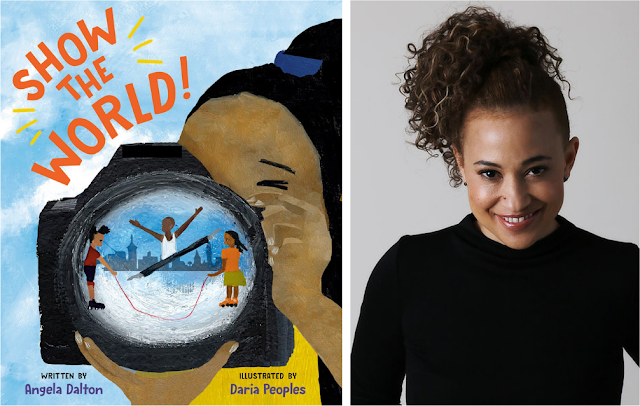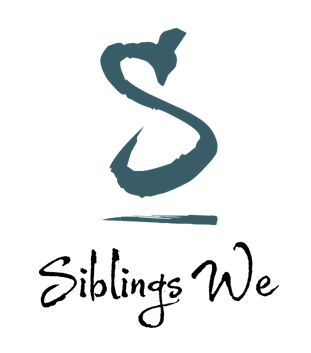The many spaces, places, and ways to
show the world all that you can be?
From painting, music, and slam poetry, to engineering, protesting, and photography, a young narrator journeys through her neighborhood, encouraging readers to explore all the many ways they can express themselves. A gorgeously illustrated and powerful celebration of self-expression shows children that there are so many spaces and opportunities to use their voices–and show the world exactly who they are.
What will you show the world?
The voice in Show The World is an unnamed narrator who seemed to be a quiet, but enthusiastic spirit observing and imagining the world a little more closely than others. I asked our editor who Angela had in mind as the narrator. She told me she envisioned a young girl walking around her community admiring her friend’s creative passions.
I dreamed Angela’s girl had a creative passion of her own as well, and the first image that popped into my mind was a girl who loves photography. It should be no surprise that I love photography. It was my first creative passion. (To this day, I still pretend to be a traveling photographer.) After our young heroine returns home from capturing her friends in their creative elements, she curates a Show The World photo book.
I also imagined this little girl lived with her grandmother. At the time I was illustrating Show The World, my grandmother’s health was rapidly declining. However, it wasn’t until the second round of sketches or so until I realized who the grandmother was in relation to me. I used to spend every summer with my grandmother as a young girl, and one of my fondest memories was helping her hang the laundry on the clothesline. I have to admit my subconscious worked on my behalf unintentionally.
And because the vision of the book is to capture Black joy, the city of Oakland seemed like the only plausible setting. It is Angela’s city and our West Coast Harlem, and a community I believe needs to be preserved and expanded with Black consciousness at its core in order for the next generation to thrive.
When I illustrate for other authors, I don’t often create the heroine’s story arc, so I also appreciated the rewarding opportunity I had to create a visual narrative for the main character.
When I know the manuscript well, and I have a good feel for where to begin, I hide it from myself, and begin sketching thumbnails. I had the extraordinary opportunity to be mentored by Floyd Cooper, and he taught me to do this. It’s something I continue to do each time I approach a new project. He encouraged me to remember the story by sketching pictures sequentially without giving too much concern for structure or form. Although, he was so good at it, editors would tell the author to revise the text to accommodate his narrative!
I learned to honor story first, and now, I never want the structure and form of a picture book to restrict my imagination. It’s a pliable form, a container that is much more expansive than it gets credit for in our industry. With each project, I challenge myself to push its perceived boundaries.
There are several rounds of sketching picture story thumbnails. Often, they they are not linear and take many different paths (as you can see). I will keep sketching until a path seems to be more direct than others. I really do want the illustrations to determine their own clear direction for me.
Once I choose a path, I begin to see how the words fits in. There is always negotiation until the day the sketches are due to the art director.
After final sketches are approved, I work out final art on one spread. I usually submit that spread for approval, then keep moving. But it’s that first spread I return to as my reference guide during the completion of final art. This was that spread for Show the World.
The only difference between me illustrating someone else’s text and my own is I usually write and revise my text as a result of the visual story. However, in early stages, I’m drawing and writing in my head. Words and pictures begin interacting in my imagination long before I write and draw the story out. I know it’s the right time to begin when one or both are moving too fast and expanding too large to live in my thoughts. And in my own work, the project grows the most through the revision process with my editor. We’re both learning how to trust this step of my process much more.
I don’t know if I have an illustration style, but I do believe I have an artistic voice. I never tailor my voice. Well, I couldn’t if I tried. It is what it is, the breath of my work, a continuation of me as an artist. But if we are talking about mediums and techniques I use, how I express my artistic voice for each manuscript, then I would say my style for the manuscript definitely depends on the heart of the story.
I don’t always get to do what I want to do. As an artist, I think my responsibility is to serve the story. The story doesn’t serve me. All of my creative choices serve the heart of the story, and this is always a little more challenging when I don’t write the story. It is also the reason why I like LOVE illustrating texts written in a similar voice as my own work. It is much easier for me to get closer to those stories as the illustrator. Show The World is definitely one of those texts.
In Show the World, I wanted the art style to be reflective of another child who was also apart of the story, demonstrating a creative passion for making art. Children like using a variety of color, and anything they can find to make art. So, Show the World is collaged and painted and glued with oil paint and pastels and acrylic and tissue paper and construction paper and pretty much everything I have in my studio. It was a fun book to make and very messy.

April 12, 2022 at 10:57AM noreply@blogger.com (Mel Schuit)
















